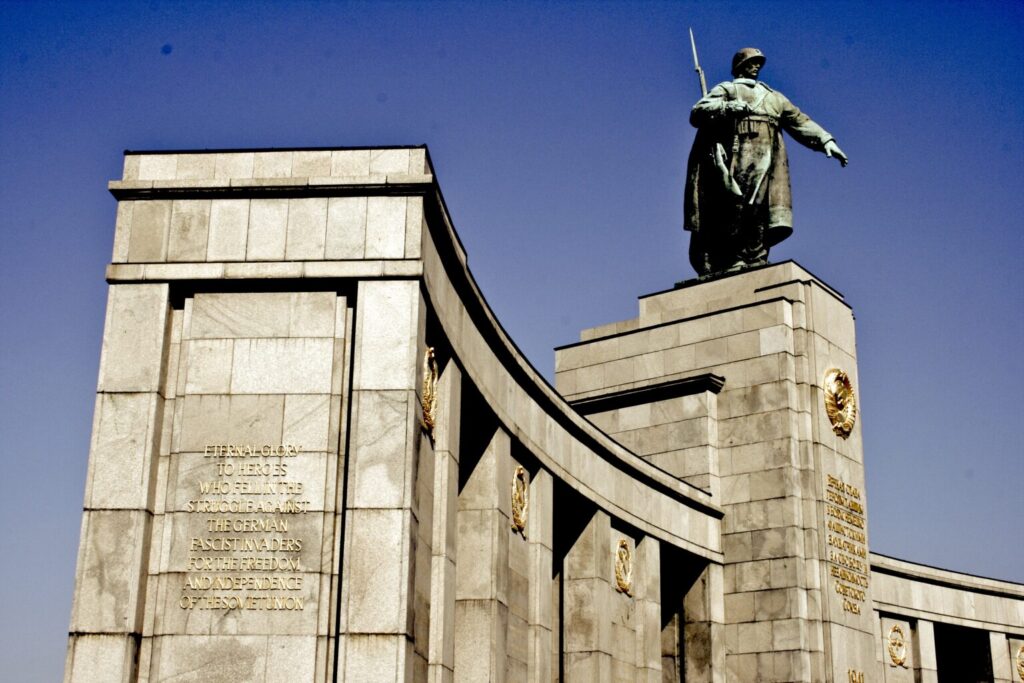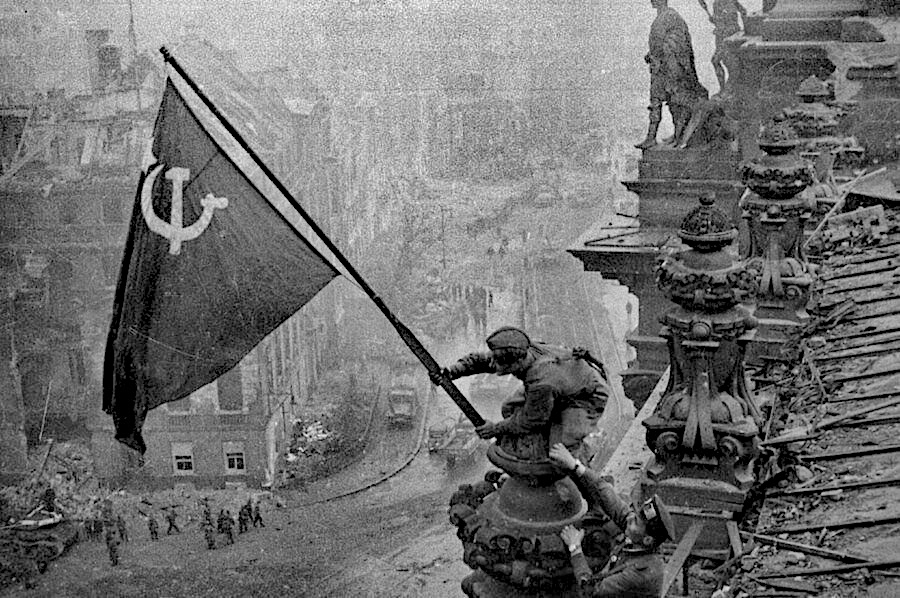The Nightmare of NATO Equipment Being Sent to Ukraine
MILITARISM, 30 Jan 2023
Scott Ritter | Consortium News - TRANSCEND Media Service
24 Jan 2023 – The West’s recent approval of more military assistance for Kiev risks nuclear nightmare, fails Ukrainian expectations, and rebukes the WWII history enshrined in a prominent Soviet war memorial in Berlin. Today the White House decided that it would send about 30 M1 Abrams tanks to Ukraine, a political cover for Germany that decided to ship 14 Leopard 2 tanks to Kiev.
Early on the morning of May 2, 1945, General Vasily Chuikov, the commander of the Soviet 8thGuards Army, accepted the surrender of the German garrison of Berlin.
Two days prior, soldiers from the 150th Rifle Division, part of the Soviet 5th Shock Army, had raised the victory banner of the Red Army over the Reichstag. An hour after the banner went up, Adolf Hitler and his mistress, Eva Braun, committed suicide in his study inside the Furhrerbunker.
Chuikov, the hero of Stalingrad whose battered 62nd Army was renamed the 8th Guards Army in honor of their victory in holding that city in the face of a massive German onslaught, had led his troops into the heart of the Nazi capital, battling stubborn Nazi resistance in the Tiergarten district of Berlin, where the den of the Nazi beast was located. The Soviet general was rewarded for the courage and sacrifice of his soldiers by being in position to accept the German surrender.
In honor of this accomplishment, and the sacrifice it entailed, the Soviet Army inaugurated, in November 1945, a commemorative monument along the Tiergarten. Constructed from red marble and granite stripped away from the ruins of Adolf Hitler’s Neue Reichskanzlei (New Imperial Chancellery), the monument, consisting of a concave colonnade of six joined axes flanked by Red Army artillery and a pair of T-34 tanks, with a giant bronze statue of a victorious Red Army soldier standing watch from the center pylon.
From 1945 until 1993, when the Russian Army withdrew from Berlin, Soviet guards stood guard over the monument. Since that time, the monument has been maintained according to the terms of the German Reunification Treaty of 1990, which brought West and East Germany together in the aftermath of the fall of the Berlin Wall.
Carved into the granite of the monument, in Cyrillic letters, is an inscription that reads “Eternal glory to the heroes who fell in battle with the German fascist occupiers for the freedom and independence of the Soviet Union.”
In a turn of events which must have Vasily Chuikov and the Soviet heroes to whom the Tiergarten war memorial was dedicated turning in their graves, the forces of fascism have once again reared their odious heads, this time manifested in a Ukrainian government motivated by the neo-Nazi ultra-nationalistic ideology of Stepan Bandera and his ilk.

Soviet military commander Vasily Chuikov, second from left, at the 62nd Army command post in Stalingrad in December 1942. (Mil.ru, CC BY 4.0, Wikimedia Commons)
Bandera and his murderous movement had been physically defeated by Soviet forces in the decade following the end of the Second World War. However, its ideology survived in a western Ukrainian diaspora formed from the survivors of that movement who found safe haven in West Germany (where Bandera himself settled until assassinated by the Soviet KGB in 1959); Canada (where Chrystia Freeland, the granddaughter of a former publisher of pro-Bandera propaganda, currently serves as deputy prime minister), and the United States (where the followers of Stepan Bandera have constructed a “heroes park” outside Ellenville, New York, including a bust of Bandera and other neo-Nazi Ukrainian ultra-nationalists.)
Related: SCOTT RITTER: The Death List
The ideology also survived in the shadows of the western Ukrainian districts that had been absorbed by the Soviet Union following the dismemberment of Poland in 1939, and later, after the reoccupation of these territories by Soviet forces in 1945.
CIA-Funded Political Underground
Here, beginning in 1956, (following the de-Stalinization policies instituted by Soviet Premier Nikita Khrushchev in the aftermath of his “secret speech” to members of the Communist Party), thousands of members of the Ukrainian Insurgent Army (UPA)/Organization of Ukrainian Nationalists-Bandera (OUN-B), who had been arrested and convicted by Soviet authorities, were released from the Gulag and returned to their homes, ostensibly to be reintegrated into Soviet society. This reintegration never materialized, however.
Instead, Ukrainian fascists, funded by the C.I.A., operated as a political underground, running sabotage operations and fomenting anti-Soviet/anti-Russian ideology amongst a population where the precepts of Ukrainian nationalist ideology ran strong.
Related: JOE LAURIA: On the Influence of Neo-Nazism in Ukraine
Following the collapse of the Soviet Union, at the end of 1991, these Ukrainian nationalists emerged from the shadows and began organizing into political parties backed by gangs of violence-prone extremists who promulgated, through physical intimidation, a cult of personality built around the person of Stepan Bandera.

Protesters with OUN-B’s red and black flag among Maidan Square protesters in Kiev, December 2013. (Nessa Gnatoush, CC BY 2.0, Wikimedia Commons)
Political parties such as Svoboda (“Freedom”) and the Right Sector came into being. Although lacking support among the majority of the Ukrainian population, these groups were able to leverage their penchant for organization and violence into a dominant role in the riots that broke out in Maidan Square in Kiev, in early 2014, that led to the ouster of democratically-elected Ukrainian President Victor Yanukovych and his replacement by a government of people hand-picked by the United States, including the future prime minister, Arseniy Yatsenyuk.
An intercepted phone call between Assistant Secretary of State Victoria Nuland and the U.S. ambassador to Ukraine, Geoffrey Pyatt, which took place in the days prior to the ouster of Yanukovych in February 2014, had Nuland positioning Yatsenyuk as the future leader of Ukraine and, in this context, was actively encouraging Yatsenyuk to coordinate with Oleh Tyahnybok, the head of Svoboda, who was being openly backed by armed radicals from the Right Sector.
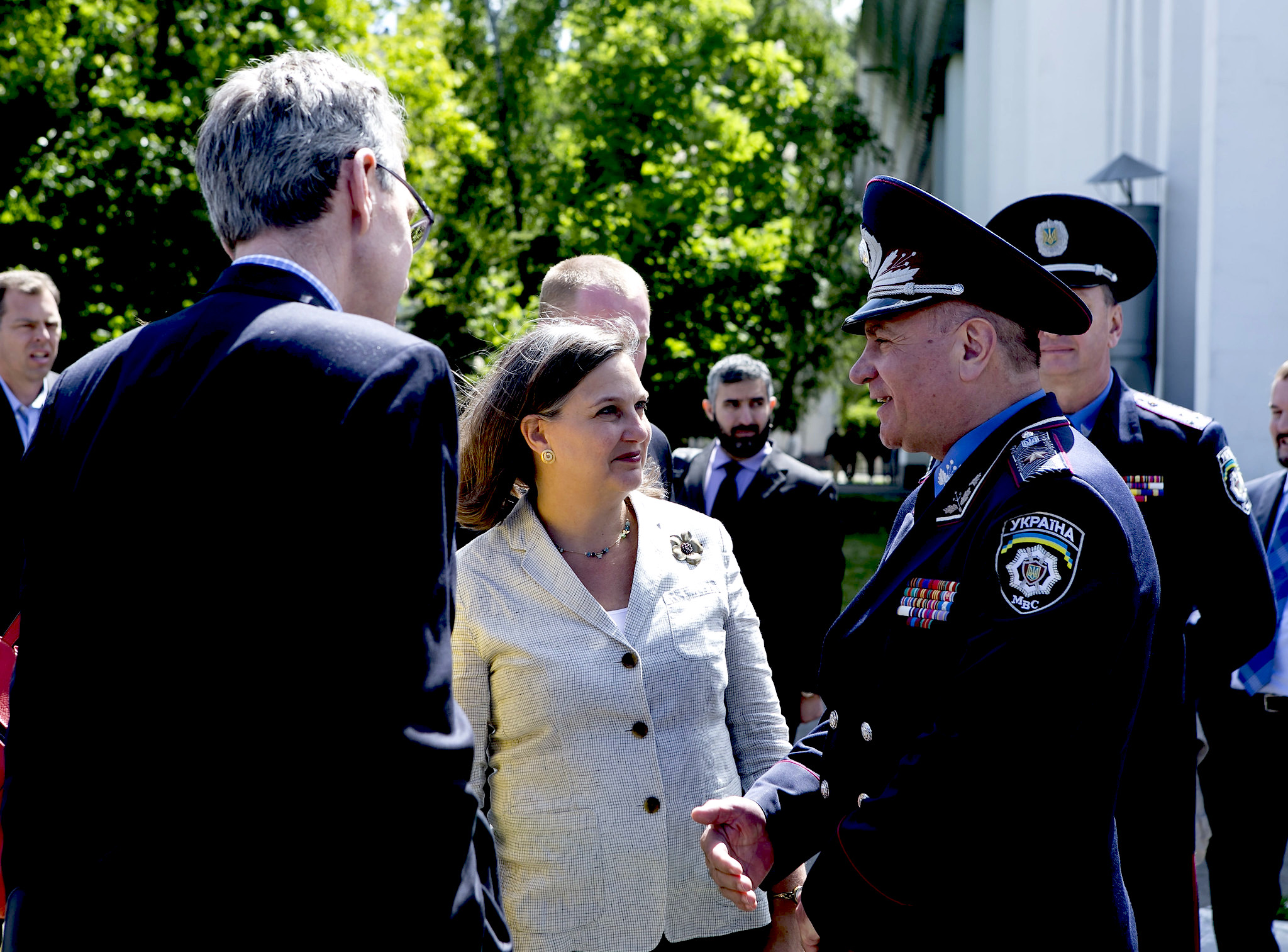
May 16, 2015: Assistant Secretary of State Victoria Nuland with U.S. Ambassador Geoffrey Pyatt (left) at the police patrol training site in Kiev, Ukraine. (U.S. Embassy Kyiv, Flickr)
The close coordination between the new post-Maidan government of Ukraine and the pro-Bandera Svoboda and Right Sector political parties manifested in these organizations having an oversized role in Ukrainian security affairs.
By way of example, Dmytro Yarosh, the former head of Right Sector, became an adviser to the commander-in-chief of the Ukrainian Armed Forces, General Valerii Zaluzhnyi. In that role, Yarosh oversaw the incorporation of numerous volunteer units of the Right Sector into the regular armed forces of Ukraine.
One of the units created because of this reorganization is the 67th Separate Mechanized Brigade, which since November 2022 has been undergoing training in the United Kingdom.
The fact that NATO members, such as the United Kingdom, are actively involved in the training of Ukrainian forces is well-established. In July 2022 the British Defense Ministry announced that it would begin training approximately 10,000 Ukrainian troops every four months.
That they are playing an active role in providing combat training to ardent neo-Nazi military formations is something Western media outlets appear to eschew.
Ukraine Defense Contact Group
The issue, however, is far more complex — and controversial — than simply providing basic military training to a few thousand adherents of Stepan Bandera’s hate-filled ideology.
The 67th Separate Mechanized Brigade is likely to be one of three Ukrainian brigade-sized formations that will be trained and equipped using billions of dollars of military assistance recently approved during the eighth session of the Ukraine Defense Contact Group.
The contact group was first convened at the sprawling U.S. Air Force base in Ramstein, Germany, in April 2022, and has served as the primary mechanism of coordination between the armed forces of Ukraine and NATO regarding the provision of training and material support to the Ukrainian military.
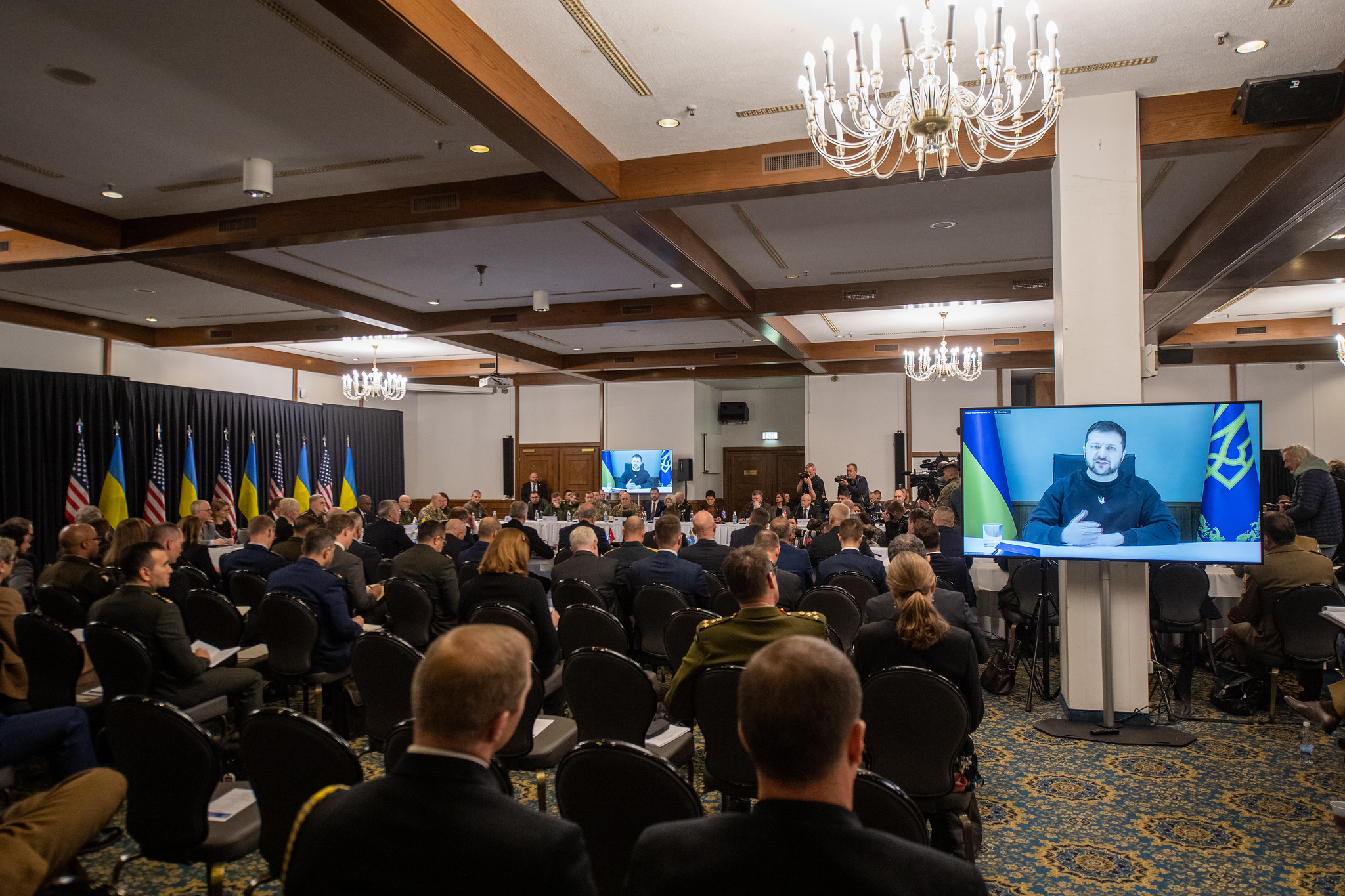
Ukraine President Volodymyr Zelensky speaks via video at the eighth Ukraine Defense Contact Group meeting at Ramstein Air Base, Germany, Jan. 20. (DoD, Jack Sanders)
The most recent convocation of the Ramstein Contact Group took place in the shadow of an interview given by the commander of the Ukrainian Armed Forces, General Valerii Zaluzhnyi, to The Economist, in December 2022. According to Zaluzhnyi, the primary problem facing Ukraine was the need “to hold this line [i.e., the Soledar-Bakhmut defensive belt] and not lose any more ground.”
Since that interview, Soledar has fallen to the Russians, and Bakhmut is threatened with being surrounded. Moreover, Russian forces are on the offensive north and south of the Bakhmut front, in some instances advancing up to seven kilometers per day.
Zaluzhnyi also stated that the second priority for Ukraine was
“to get ready for this war which can happen in February [2023]. To be able to wage a war with fresh forces and reserves. Our troops are all tied up in battles now, they are bleeding. They are bleeding and are being held together solely by courage, heroism, and the ability of their commanders to keep the situation under control.”
The Ukrainian commander noted that the February “war” would have Ukraine resuming the attack:
“We have made all the calculations — how many tanks, artillery we need and so on and so on. This is what everyone needs to concentrate on right now. May the soldiers in the trenches forgive me, it’s more important to focus on the accumulation of resources right now for the more protracted and heavier battles that may begin next year.”
The goal of this offensive, Zaluzhnyi said, was to push Russia back to the borders that existed on Feb. 23, 2022, the start of the Russian invasion. He also indicated that the liberation of Crimea was an objective.
“In order to reach the borders of Crimea, as of today we need to cover a distance of 84 km to Melitopol [a strategic city in the south of the Donetsk Republic]. By the way, this is enough for us, because Melitopol would give us a full fire control of the land corridor, because from Melitopol we can already fire at the Crimean Isthmus.”
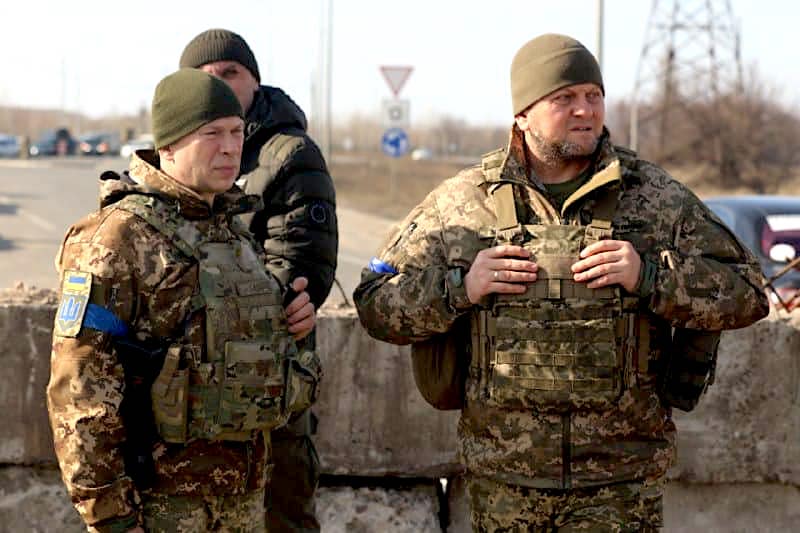
General Valerii Zaluzhnyi, right, with Colonel General Oleksandr Syrskyi during the Battle of Kiev, March 2022. (Commander in Chief of Ukraine, CC BY 4.0, Wikimedia Commons)
Zaluzhnyi exuded confidence. “I know that I can beat this enemy,” he said. “But I need resources. I need 300 tanks, 600-700 IFV’s [infantry fighting vehicles], 500 Howitzers. Then, I think it is completely realistic to get to the lines of February 23rd.”
Zaluzhnyi spoke of an upcoming meeting with U.S. General Mark Milley, chairman of the Joint Chiefs of Staff. “I will tell him [Milley] how much it is worth, how much it costs. If we don’t get it, of course we will fight to the end. But as a movie character said, ‘I don’t vouch for the consequences.’ The consequences are not hard to foresee. This is what we have to do.”
In short, Zaluzhnyi was saying he could win the war with Russia if he received the requested amount of military equipment. Otherwise, Ukraine would likely lose the conflict.
The Eighth Session
The eighth session of the Ramstein Contact Group convened on Jan. 20 and the Ukrainians pressed hard for their Western allies to provide the material support Zaluzhnyi had requested.
Defense ministers from more than 50 countries participated, including Ukraine’s Oleksii Reznikov who, speaking at the Davos World Economic Forum a few days before the Ramstein meeting, declared that “We [Ukraine] are carrying out NATO’s mission today. They aren’t shedding their blood. We’re shedding ours. That’s why they’re required to supply us with weapons.”
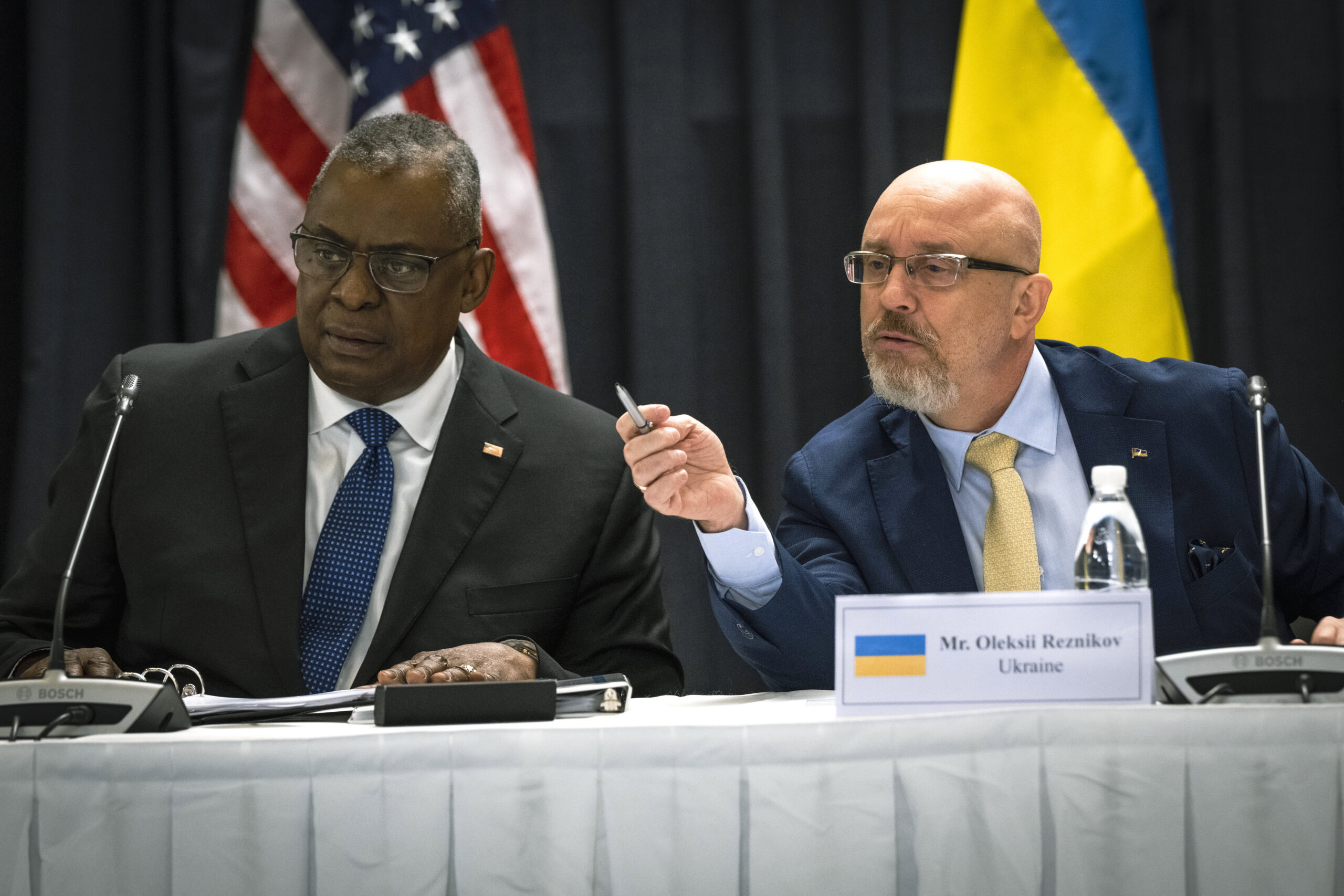
Ukrainian Minister of Defense Oleksii Reznikov, right, with U.S. Secretary of Defense Lloyd Austin during a Ukraine Defense Contact Group meeting at Ramstein Air Base, Germany, Sept. 8, 2022. (DoD, Chad J. McNeeley)
The Contact Group took the Ukrainian demand for material support under consideration, and by the end of the meeting had committed to providing Ukraine with a multi-billion dollar support package, including air defense weapons, artillery ammunition, support vehicle, and (perhaps most importantly) approximately 240 of the 500 infantry fighting vehicles it had requested, broken down roughly into one battalion (59 vehicles) of U.S.-made M-2 Bradleys, two battalions (90 vehicles) of M-1126s, one battalion (40 vehicles) of German Marders and one battalion (approximately 50 vehicles) of Swedish-made CV90s.
The Ramstein Contact Group also promised delivery of four self-propelled artillery battalions, consisting of 19 Swedish-made Archer’s, 18 British-made AS-90’s, 18 U.S.-made M-109 Paladin’s, and a dozen French-made CEASAR’s. When added to the 24 towed FH-70 pieces, the total of artillery pieces being sent to Ukraine amounts to just under 100 artillery pieces, a far cry from the 500 requested by Zaluzhnyi.
Missing from the Ramstein Contact Group list was anything remotely resembling the 300 tanks Zaluzhnyi had requested; the best Ukraine’s European allies could muster [until Tuesday] was a promise from the United Kingdom to supply a company’s worth (14) of Challenger 2 main battle tanks.
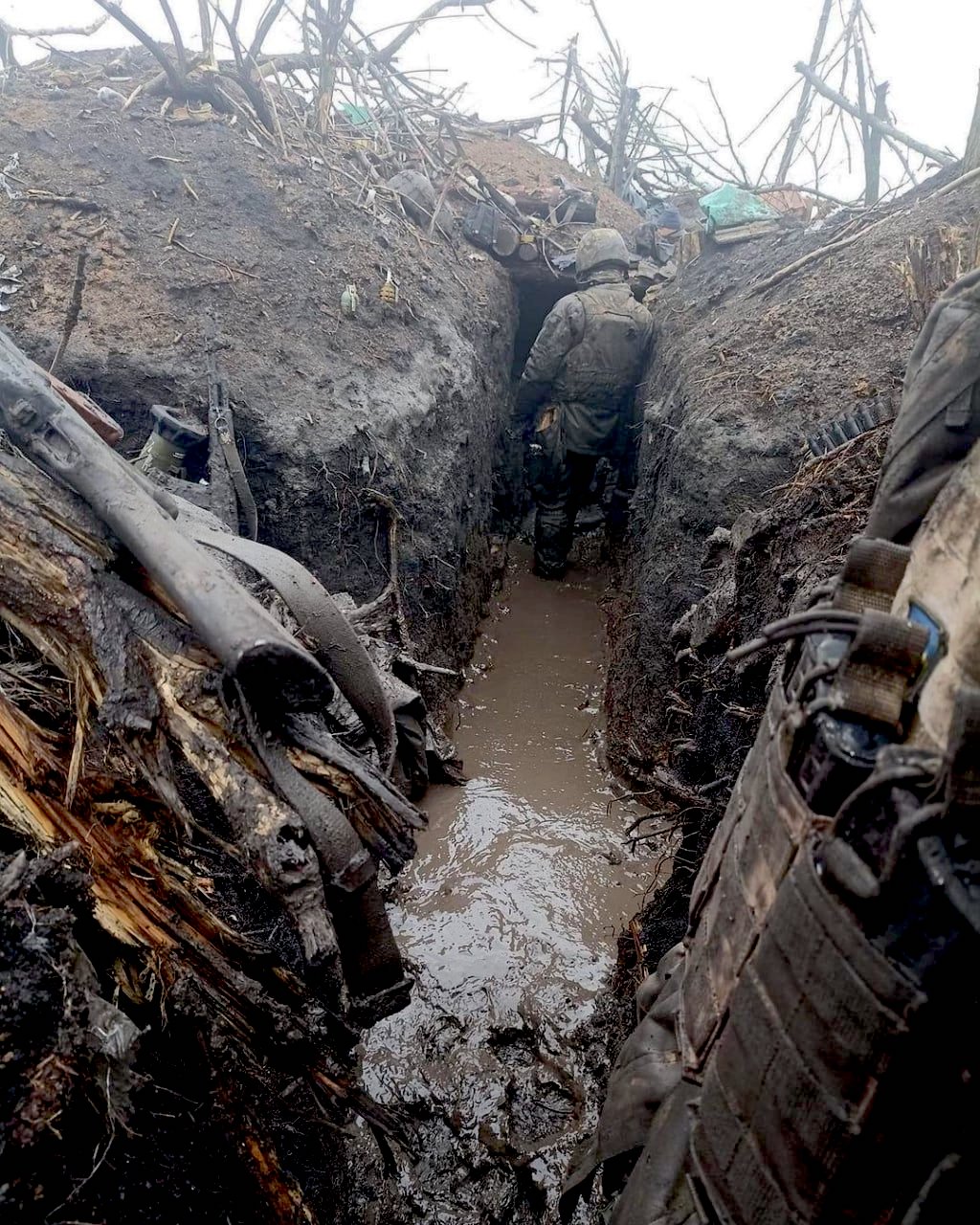
Ukrainian trenchline at the Battle of Bakhmut, November 2022. (Mil.gov.ua, CC BY 4.0, Wikimedia Commons)
Zaluzhnyi, in his interview with The Economist, had indicated that he could not accomplish his planned offensive with anything less than the three armored and three mechanized brigade-equivalents he had requested.
The collective West had responded with barely two brigade’s worth of equipment.
These two, when added to a third mechanized brigade that had previously been formed and was undergoing training in Poland, gave the Ukrainian general half of what he claimed he needed to launch a successful offensive against Russia.
For U.S. General Milley, the equipment shortfall wasn’t the issue — training was. Prior to arriving at Ramstein, Milley toured the sprawling Grafenwoehr training grounds in Germany. There the U.S. Army is in the process of training some 600 Ukrainian soldiers to effectively move and coordinate their company-and battalion-size units in battle, using combined artillery, armor and ground forces.
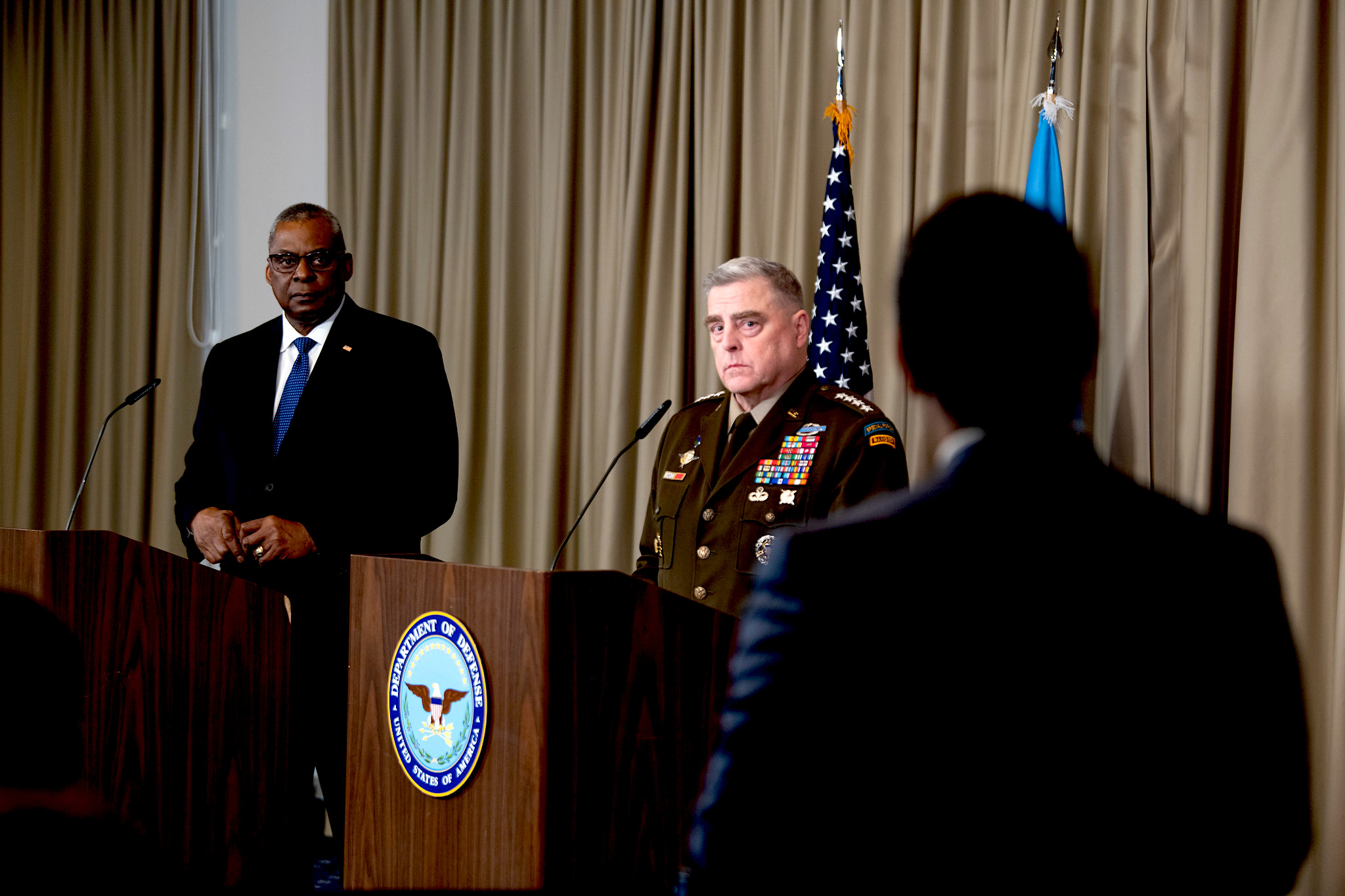
Gen. Mark A. Milley, chairman of the Joint Chiefs of Staff, at podium during a press briefing after a Ukraine Defense Contact Group meeting at Ramstein Air Base, Germany, on Jan. 20. U.S. Secretary of Defense Lloyd J. Austin on left. (DoD, Jack Sanders)
Speaking to reporters, General Milley said such training was critical in helping Ukraine recapture territory lost to Russia last year. The goal of this training, Milley said, is for incoming weapons and equipment to be delivered to Ukraine so the newly trained forces will be able to use it “sometime before the spring rains show up. That would be ideal.”
What the West is Giving
Operational training, no matter how competently delivered and absorbed, does not paint an accurate picture of the true combat capability being turned over to Ukraine by the West. The reality is most of this equipment won’t last a month under combat conditions; even if the Russians don’t destroy them, maintenance issues will.
Take, for instance, the 59 M-2 Bradley vehicles being supplied by the United States. According to anecdotal information obtained from Reddit, the Bradley is, to quote, “a maintenance NIGHTMARE.”
“I can’t even begin to commiserate how f***ing awful maintenance on a Bradley is,” the author, a self-described U.S. Army veteran who served in a Bradley unit in Iraq, declared.
“Two experienced crews MIGHT be able to change one Brad’s track in 3 or 4 hours, if nothing goes wrong (something always goes wrong). Then you got the track adjuster arms, the shock arms, the roadwheels, the sprocket itself, that all need maintained and replaced as needed. I haven’t even started talking about the engine/transmission pack yet. When you do services on that, it’s not like you just raise the engine deck lid. You got to take the armor OFF the Bradley so an M88 Wrecker vehicle can use its crane to LIFT the engine/tranny out of the hull.”
The Stryker isn’t any better. According to a recent article in Responsible Statecraft, U.S. soldiers who used the vehicle in both Iraq and Afghanistan called the Stryker “a very good combat vehicle, so long as it traveled on roads, it wasn’t raining — and didn’t have to fight.”
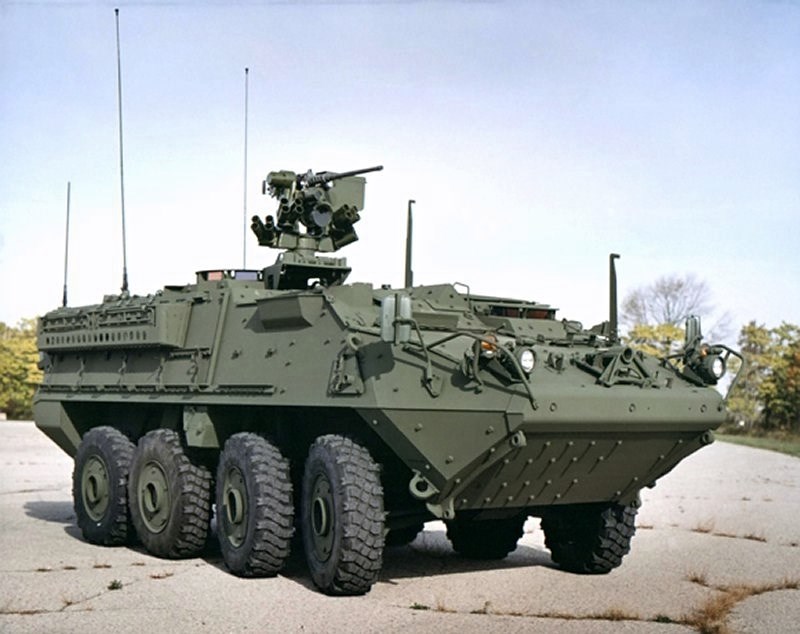
Stryker Infantry Carrier Vehicle, M1126. (U.S. Army, Public domain, Wikimedia Commons)
The Stryker is also a difficult system to maintain properly. One of the critical features of the Stryker is the “height management system,” or HMS. In short, it is what keeps the hull from riding on the tires. A failure to constantly maintain and monitor the HMS system will result in the hull rubbing up against the tires, causing tire failure and a non-operable vehicle.
The HMS is complex, and a failure to maintain or operate one component will result in the failure of the entire system. The likelihood of the future Ukrainian operators of the Stryker properly maintaining the HMS under combat conditions is near-zero — they will lack the training as well as the “logistical support” necessary (such as spare parts).
The German Marder IFV appears to represent a similar maintenance headache for the Ukrainians: according to a 2021 article in The National Interest, “The vehicle was considered unreliable from the outset: Tracks rapidly wore out, transmissions often failed, and soldiers could not easily remove the vehicle’s engine for field maintenance.”
While Germany is preparing to invest a significant amount of money to upgrade the Marder, this hasn’t yet been done. Ukraine is inheriting an old weapons system that brings with it a considerable maintenance problem Ukraine is not prepared to properly handle.
The Swedish CV 90 saw some limited combat in Afghanistan when deployed with the Norwegian Army. While there is not enough publicly available data about the maintainability of this system, one only needs to note that even if the SV 90 proves easy to maintain, it represents a completely different maintenance problem from that of the Bradly, Stryker, or Marder.
In short, to properly operate the five battalion-equivalents of infantry fighting vehicles being supplied their NATO partners, Ukraine will need to train its maintenance troops on four completely different systems, each with its own unique set of problems and separate logistical/spare part support requirements.
It is, literally, a logistical nightmare that will ultimately prove to be the Achilles heel of the Ramstein tranche of heavy equipment.
But even here, neither NATO nor Ukraine seems able to see the forest for the trees. Rather than acknowledging that the material being provided is inadequate to the task of empowering Ukraine to carry out large-scale offensive operations against Russia, the two sides began haranguing each other over the issue of tanks, namely the failure of Germany to step up to the plate in Ramstein and clear the way for the provision to Ukraine of hundreds of modern Leopard 2 main battle tanks.
German History & Optics
The Ramstein meeting was hampered by concern within the German Parliament over the optics associated with Germany providing tanks which would be used to fight Russians in Ukraine.
This angst was perhaps best captured by Petr Bystron of the right-wing Alternative for Germany party. “German tanks [fighting] against Russia in Ukraine,” Bystron challenged his colleagues, “remember, your grandfathers tried to do the same trick, together with [Ukrainian nationalists] Melnik, Bandera and their supporters.
“The result was immense suffering, millions of casualties on both sides and, eventually, Russian tanks came here, to Berlin. Two of those tanks remain on permanent display nearby, and you must keep this in mind when you pass them by every morning,” Bystron said, referring to the two Soviet T-34 tanks at the Tiergarten memorial to fallen Soviet soldiers.
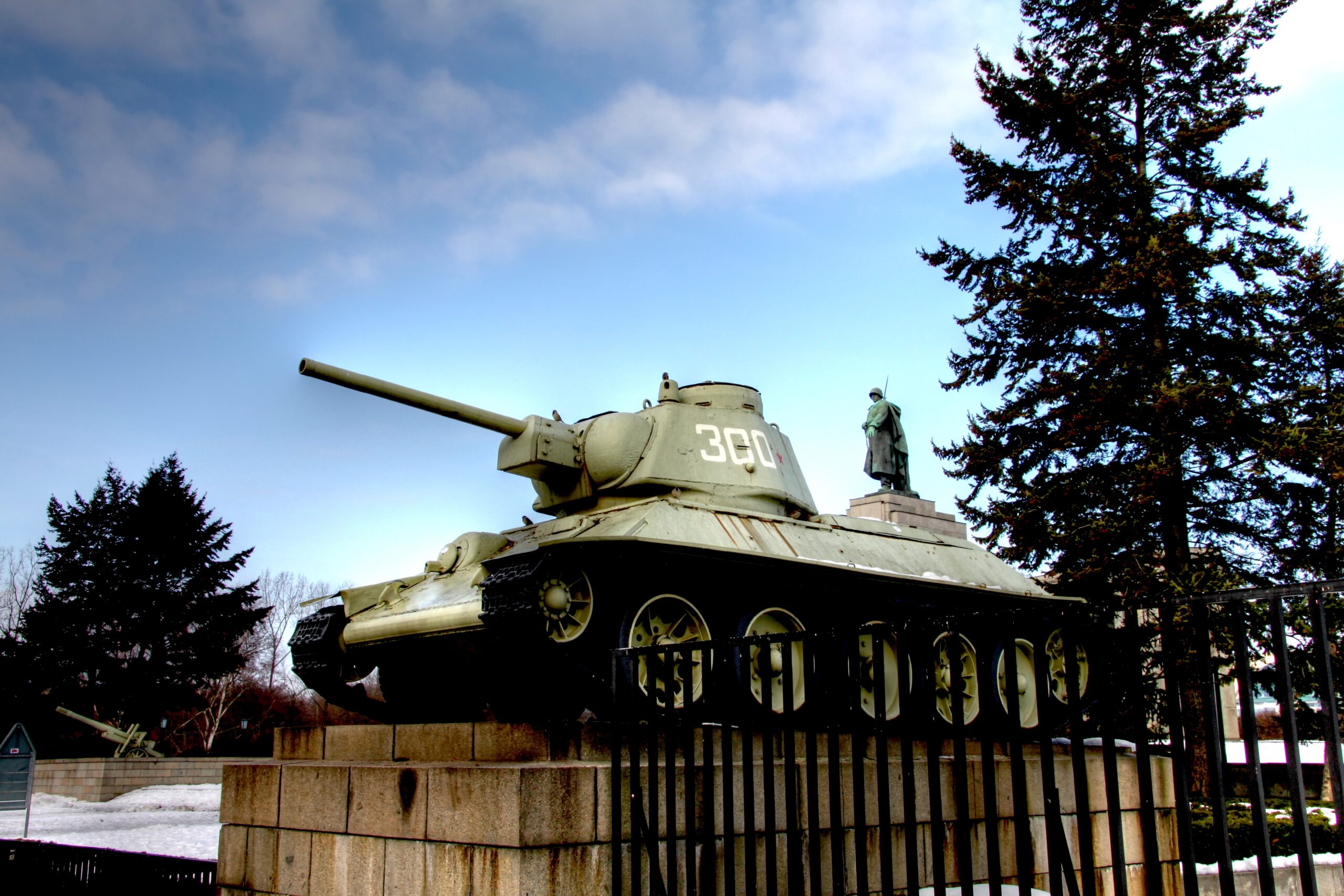
Soviet War Memorial in the Tiergarten, West Berlin. (Klearchos Kapoutsis, CC BY 2.0, Wikimedia Commons)
The issue of Leopard tanks, however, was more political than technical, with Poland threatening to ignore Germany’s refusal to allow the tanks to be sent to Ukraine, announcing that it was prepared to dispatch 14 of its own Leopard 2 tanks to Ukraine in the near future. When combined with the 14 Challenger 2 tanks being promised by the British, Ukraine was getting 28 of the 300 tanks it said it needed for any future offensive. [Now roughly 58 with the U.S. Abrams.]
The numerical disparities and maintenance difficulties aside, NATO politicians seem quite pleased with what was accomplished at Ramstein. According to British Defense Secretary Ben Wallace, in an address to Parliament,
“The international community recognizes that equipping Ukraine to push Russia out of its territory is as important as equipping them to defend what they already have. Today’s package is an important increase in Ukraine’s capabilities. It means they can go from resisting to expelling Russian forces from Ukrainian soil.”
Wallace seems to ignore that by empowering Ukraine to expel Russian troops from what are — following the annexation of the four former Ukrainian territories (Lugansk, Donetsk, Zaporizhia and Kherson) last September — permanently part of the Russian Federation, NATO would be potentially creating the conditions under which Russia would be able to doctrinally employ nuclear weapons. Those conditions would be to defend against the accumulation of conventional military power capable of threatening the existential survival of Russia.
Russia, however, has not ignored this. Speaking after the Ramstein Contact Group finished its meeting, Kremlin spokesman Dmitry Peskov told reporters “Potentially, this is extremely dangerous, it will mean bringing the conflict to a whole new level, which, of course, will not bode well from the point of view of global and pan-European security.”
Senior Russian officials chimed in on social media. Anatoly Antonov, the Russian ambassador to the United States, declared on his Telegram channel that:
“It should be clear for everyone — we will destroy any weapons supplied to the Zelensky’s regime by either the United States or NATO. That is true now as it was true during the Great Patriotic War. The emergence of tanks, bearing Nazi insignia, on the former Soviet soil unequivocally makes us aim at toppling the neo-Nazi regime in Ukraine and creating normal conditions so that the neighboring peoples in the region could live peacefully like in the old days.”
Dmitri Medvedev, a former Russian president and close adviser to Russian President Vladimir Putin, added on Twitter that those who promote a Russian defeat risk unleashing global ruin. “None of them gets it that a nuclear power’s loss of a conventional war can lead to a nuclear one. Nuclear powers haven’t been defeated in major conflicts crucial for their destiny.”
The Consequences for Ukraine
The reality is, however, that the consequences of the Ramstein Contact Group’s work will be far more detrimental to Ukraine than Russia.
Under pressure from the West to carry out a major offensive designed to expel Russian forces from the territories captured last year, General Zaluzhnyi will be compelled to sacrifice whatever reserves he would be able to assemble in the aftermath of Ramstein for the purpose of engaging in fruitless attacks against a Russian opponent that is far different from the one Ukraine faced in September and October of last year.
Then, a reconstituted Ukrainian army, bolstered by tens of billions of dollars of NATO equipment, training and operational support, was able to take advantage of over-extended Russian forces to recapture large swaths of territory in Kharkov and Kherson.
Today, Russia’s military presence in Ukraine is a far cry from what it was in the autumn of 2022. In the aftermath of Putin’s September 2022 decision to mobilize 300,000 reservists, Russia has not only consolidated the frontline in eastern Ukraine, assuming a more defensible posture, but also reinforced its forces with some 80,000 mobilized troops, allowing for Russia to sustain offensive operations in the Donetsk regions while solidifying its defenses in Kherson and Lugansk.
From Feb. 24 through the autumn of 2022, Russia deviated significantly from how it doctrinally prosecutes armed conflict. Moving forward, Russia will be waging war by the book. Defensive positions will be laid in a manner designed to defeat concerted NATO attack, both in terms of troop density along the frontline, but also in depth (something lacking in the Kharkov offensive in September 2022) and with sufficient dedicated fire support (again, lacking in September 2022).
By General Zaluzhnyi’s own admission, Ukraine has insufficient forces for the task. Even if Ukraine were able to concentrate all three brigades’ worth of men and material that are in the pipeline following the Ramstein Contact Group meeting at one place at the same time, the 20,000 or so troops this represents would be unable to breach a Russian defensive position laid out in doctrinal fashion.
Ukraine and NATO should heed the history lesson that Petr Bystron presented to his fellow German parliamentarians — German tanks do not historically fare well against Russian tanks on Ukrainian soil.
And Ben Wallace and Mark Milley should pay attention to the order of battle of the Russian forces opposing the Ukrainian Army, especially around the critical battlefields in and around the strategic city of Bakhmut. There, Russian soldiers belonging to the 8th Guards Army are poised to continue in the tradition of Vasily Chuikov’s heroes of Stalingrad and Berlin, destroying the forces of fascism on the field of battle.
While the modern-day soldiers of the 8th Guards Army may not be mounting a new generation of tanks on display in the Berlin Tiergarten, rest assured they know fully well their historical legacy and what is expected of them.
This, more than anything else, is the true expression of the Ramstein effect, a cause-effect relationship that the West does not seem either able or willing to discern before it is too late for the tens of thousands of Ukrainian soldiers whose lives are about to be sacrificed on an altar of national hubris and ignorance.
________________________________________
 Scott Ritter was a US Marine Corps intelligence officer for 12 years. As a chief weapons inspector for the UN Special Commission in Iraq, he was labeled a hero by some, a maverick by others and a spy by the Iraqi government. In charge of searching out weapons of mass destruction within Iraq, Ritter was on the front lines of the ongoing battle against arms proliferation. He has had an extensive and distinguished career in government service with assignments in the former Soviet Union and the Middle East. In 1991, Ritter joined the United Nations weapons inspections team, or UNSCOM. He participated in 34 inspection missions, 14 of them as chief inspector. Ritter resigned from UNSCOM in August 1998, citing U.S. interference in the inspections. He is the author of many books, including Scorpion King: America’s Suicidal Embrace of Nuclear Weapons from FDR to Trump; Iraq Confidential: The Untold Story of the Intelligence Conspiracy to Undermine the UN and Overthrow Saddam Hussein; Target Iran: The Truth about the White House’s Plans for Regime Change; and Waging Peace: The Art of War for the Antiwar Movement. Contributor author: Deal of the Century: How Iran Blocked the West’s Road to War, Clarity Press. He is a graduate of Franklin and Marshall College, with a B.A. in Soviet history.
Scott Ritter was a US Marine Corps intelligence officer for 12 years. As a chief weapons inspector for the UN Special Commission in Iraq, he was labeled a hero by some, a maverick by others and a spy by the Iraqi government. In charge of searching out weapons of mass destruction within Iraq, Ritter was on the front lines of the ongoing battle against arms proliferation. He has had an extensive and distinguished career in government service with assignments in the former Soviet Union and the Middle East. In 1991, Ritter joined the United Nations weapons inspections team, or UNSCOM. He participated in 34 inspection missions, 14 of them as chief inspector. Ritter resigned from UNSCOM in August 1998, citing U.S. interference in the inspections. He is the author of many books, including Scorpion King: America’s Suicidal Embrace of Nuclear Weapons from FDR to Trump; Iraq Confidential: The Untold Story of the Intelligence Conspiracy to Undermine the UN and Overthrow Saddam Hussein; Target Iran: The Truth about the White House’s Plans for Regime Change; and Waging Peace: The Art of War for the Antiwar Movement. Contributor author: Deal of the Century: How Iran Blocked the West’s Road to War, Clarity Press. He is a graduate of Franklin and Marshall College, with a B.A. in Soviet history.
Go to Original – consortiumnews.com
Tags: Arms Trade, Bullying, Eastern Europe, European Union, Hegemony, Imperialism, Military Industrial Media Complex, NATO, Nuclear war, Official Lies and Narratives, Pentagon, Proxy War, Russia, US Military, US empire, USA, Ukraine, War Economy, Warfare, West
DISCLAIMER: The statements, views and opinions expressed in pieces republished here are solely those of the authors and do not necessarily represent those of TMS. In accordance with title 17 U.S.C. section 107, this material is distributed without profit to those who have expressed a prior interest in receiving the included information for research and educational purposes. TMS has no affiliation whatsoever with the originator of this article nor is TMS endorsed or sponsored by the originator. “GO TO ORIGINAL” links are provided as a convenience to our readers and allow for verification of authenticity. However, as originating pages are often updated by their originating host sites, the versions posted may not match the versions our readers view when clicking the “GO TO ORIGINAL” links. This site contains copyrighted material the use of which has not always been specifically authorized by the copyright owner. We are making such material available in our efforts to advance understanding of environmental, political, human rights, economic, democracy, scientific, and social justice issues, etc. We believe this constitutes a ‘fair use’ of any such copyrighted material as provided for in section 107 of the US Copyright Law. In accordance with Title 17 U.S.C. Section 107, the material on this site is distributed without profit to those who have expressed a prior interest in receiving the included information for research and educational purposes. For more information go to: http://www.law.cornell.edu/uscode/17/107.shtml. If you wish to use copyrighted material from this site for purposes of your own that go beyond ‘fair use’, you must obtain permission from the copyright owner.
